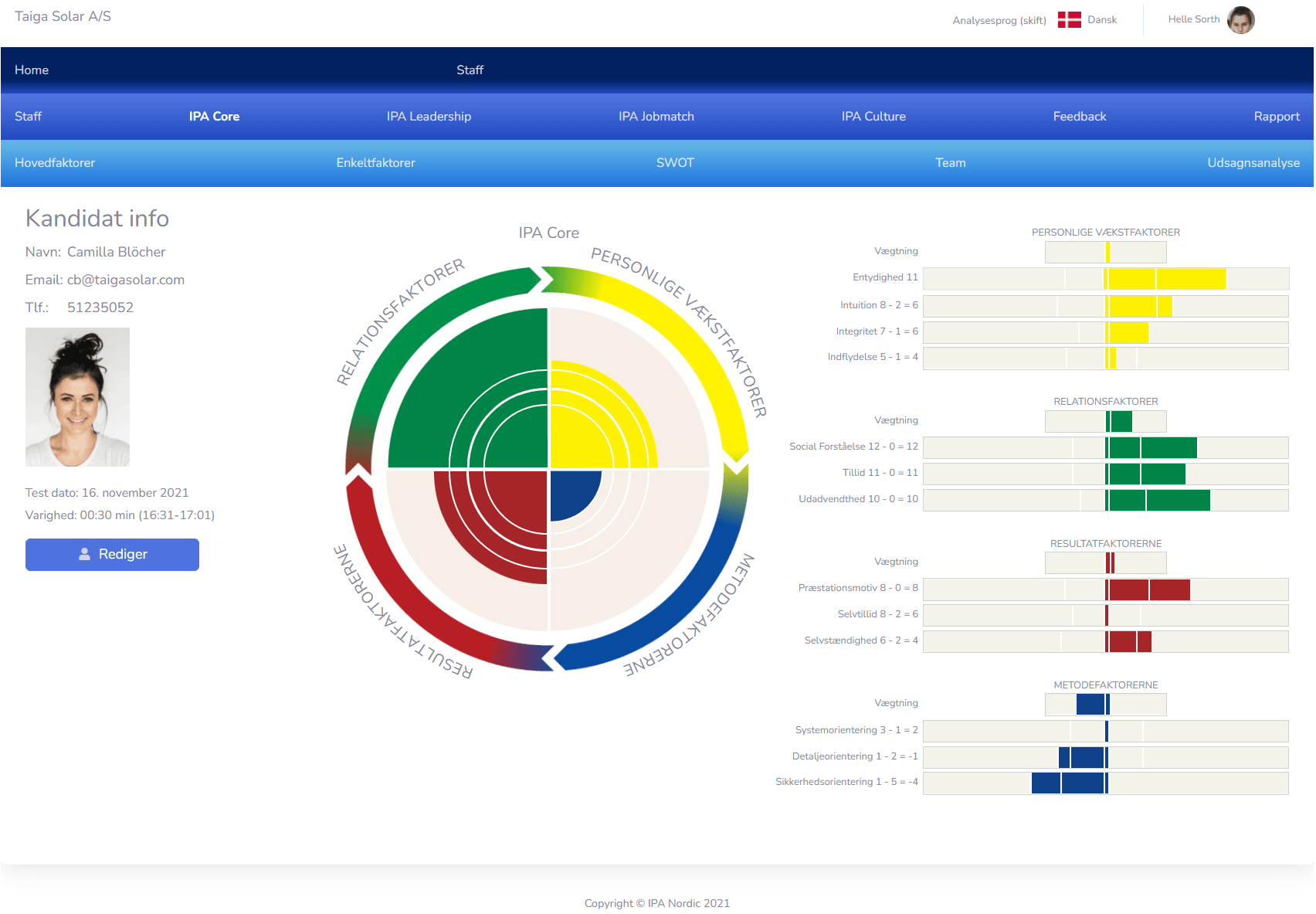25% of all new hires
leaves within 12 months
It costs companies between
75%-150% of an annual salary

Rule management

Individual Goal Orientation

Co-operation orientation

Change orientation
Introduction to the IPA JobMatch
IPA JobMatch er en job analyse, der ser jobbet indefra.
JobMatch er bygget så intelligent, at det matcher IPA Core, og de kan spejles i hinanden.
IPA JobMatch sikrer en klar intern forventningsafstemning af jobbet, inden det annonceres.
Researcher Flemming Olsen talks about IPA Nordic’s JobMatch analysis
Why choose IPA JobMatch?
Top rated personality analysis
Author of top rated personality analysis
Multi language
IPA JobMatch covers more than 80% of the world’s population.
State of the art technologi
Together with the IPA Core comes the IPA 360° Cockpit, where the analyses can be processed and analysed. See IPA 360° Cockpit
IPA JobMatch- Main factor # 1
Rule management
To what extent is the performance of tasks characterised by a clear and well-structured management of efforts, a rule- and routine-oriented daily routine and a case-oriented and professional approach to tasks. Thoroughness, professionalism and precision in the performance of tasks are rewarded.
Colour: Blue

JobMatch trait # 1
System content
The extent to which the job is characterised by clear guidelines, order and stability. The degree of opportunity and need for detailed planning based on a structural overview. The degree of need to systematise, create routines and visible and tangible rules.

LOW SYSTEM CONTENT
The tasks are solved in an ever-changing universe characterized by a high degree of freedom in terms of both content and method. Here you can improvise, try out multiple options and make mistakes along the way. You learn from this. You must be able to quickly adapt to new conditions, new ideas and new ideas, and thus be both flexible and accommodating to whatever changing tasks, conditions and challenges may arise. In short, you need to be able to navigate in a universe where almost nothing is a foregone conclusion.
HIGH SYSTEM CONTENT
The job is characterized by order, regularity and stability, and there are good opportunities to get an overview of where you are in the tasks and what you are missing. The ability to plan and organize your efforts is important for success, and the best way to achieve your goals is to be systematic, thorough and meticulous in your approach. A certain amount of caution is required, as solutions need to work the first time they are implemented. It’s a job characterized by
clear guidelines and fairly unambiguous rules for the way you approach your tasks.
JobMatch trait # 2
Routine content
The degree to which tasks must be solved towards an accurate and correct result. To follow certain routines to reduce the risk of making mistakes. To be able to control and check that you are on the right track and make sure that what you are doing is 100% correct. The extent to which the success criteria are based on deep professional and specialist knowledge in a well-defined area.

LOW ROUTINE CONTENT
The tasks are characterized by the fact that you don’t know the exact result in advance. There is no exact answer. For this reason, the job requires a sense of working with the big picture and an ability to assess the big picture and find the pattern in fairly complex contexts. The success criteria are initially rather unclear, measurability is low, and you often have to initiate tasks on an uncertain basis. Generally speaking, the achievement of results is some way off in the future.
HIGH ROUTINE CONTENT
The job requires both patience and an interest in digging deep into each task. It’s crucial that the task is done the right way, as mistakes can have major consequences. It’s possible to check if you’re on the right track, and you don’t let go of the task until you’re sure it’s done
correctly. The job requires professional skills in the field, perseverance and the desire to immerse yourself in details. It is in the nature of the job that it is characterized by
repetitive routines, as this ensures that mistakes are avoided.
Job Match trait # 3
Predictability
The extent to which you perform your tasks in a predictable world, where you know the consequences of your choices and actions. Patience and thoughtfulness are rewarded, and there is plenty of time to research and test things before making a final decision. The level of risk is low and situations involving surprise and uncertainty are rare.

LOW PREDICTABILITY
The job is characterized by the need to act quickly and on an uncertain basis. You don’t know the full consequences of your decisions in advance, and you
you have to be ready to set things in motion without knowing where you’ll end up. So, the job is characterized by a fair amount of uncertainty when making a decision,
and there are usually several options and paths you can take. The job requires you to be able to navigate in a universe that is sometimes characterized by uncertainty and unpredictability.
HIGH PREDICTABILITY
The job is characterized by a high degree of predictability, and it is possible to assess and calculate the outcome of your tasks before you start. The risk content is therefore low and the universe you work in is known and well-defined. It’s a job and an environment where thoughtfulness and a certain amount of caution is appreciated, and where it doesn’t matter if you’re a slow decision-maker. You know most outcomes and consequences before you set things in motion.
IPA JobMatch – Main factor # 2
INDIVIDUAL GOAL ORIENTATION
To what extent is the focus on individual performance and individual success, high expectations and a competitive environment with clear goals for the individual. Determination, speed and individual goal achievement are rewarded.

JobMatch trait # 4
Individual performance requirements
The extent to which individual performance matters most in a work environment characterised by internal competition and high measurability of performance. An environment where individuals and each other are pushed and challenged to perform at their best. People compare each other’s performance and reward those who achieve the most, often pursuing their own goals more than the common ones.

LOW INDIVIDUAL ORIENTATION
Here, you are more oriented towards the community and the group’s results rather than what the individual can achieve. You don’t get exposed and highlighted in relation to others, but are more aware of the results you create together. You accept that not everyone can run at the same speed, but maybe they can contribute in other ways. And the pace is adapted to this mindset so that you don’t have to constantly chase certain goals. There are limits to what you will demand from each individual, and you don’t like to constantly measure people’s efforts against each other.
HIGH INDIVIDUAL ORIENTATION
Here, individual performance counts for a lot in the accounts, and for this reason, the job is characterized by clear and measurable goals so that you can always see what the
individual employee has performed. The environment is competitive and you strive to achieve the most and the furthest. This is also what you are rewarded for, both
quantitatively, but also in terms of attention and exposure. It’s all about becoming better, faster and more efficient in the execution of your tasks. You challenge each other and give it your all.
JobMatch trait # 5
Stress level
The degree to which the job presents situations where stressful resistance and adversity must be faced and overcome. The degree to which you are challenged and thrown into uncharted waters where you basically have to fend for yourself. New tasks, unfamiliar situations and critical boundary testing.

LOW STRESS LEVEL
This is mostly familiar terrain with tasks that most people have tried before. It is legitimate to say no to tasks you don’t feel comfortable solving, and
You work with familiar material and tried and tested methods. The environment is set up in such a way that there is ample opportunity to get help and support in critical situations, and there is also room for uncertainty and doubt about whether your abilities are up to the task. People protect and support each other to ensure a safe environment for everyone in the company, and it
rarely are you put under pressure and put in unfamiliar situations.
HIGH STRESS LEVEL
Quite simply, the job requires a high and solid level of self-confidence. In some situations, you’re in deep water and uncharted waters where you only have yourself to
to rely on. You often have to take on completely new tasks without any experience to draw on. Quite the contrary. You need to feel challenged by new tasks. Perhaps because
because you find them exciting, or maybe because you think you can learn something new and test new boundaries. Above all, you must have the courage and
energy to overcome adversity and resistance.
JobMatch trait # 6
Degrees of freedom
The extent to which you are able to set the agenda and decide how you will carry out your tasks. The emphasis on personal responsibility and the way in which the working environment supports the individual’s desire for freedom and space to do things for themselves. It is a working environment characterised by few constraints, restrictions and external management.

LOW DEGREE OF FREEDOM
The job is characterized by the fact that you generally have to adapt to the common rules of the game that exist. You rely heavily on each other to solve tasks, and
The working environment is characterized by using each other, asking each other for advice and interfering in each other’s way of solving tasks. People are happy to share responsibility with each other and don’t feel the need to put their personal stamp on everything they do. The vast majority of tasks are solved jointly across the company, which is why the ability to bend and adapt to others is also important for things to work.
HIGH DEGREE OF FREEDOM
The job is characterized by great freedom to solve your own tasks without interference unless you ask for it. It’s a job where you set the agenda and decide how tasks are to be solved. You are self-motivated and free individuals who primarily collaborate where it increases efficiency and contributes to the task solution. In other words, there is plenty of room for individual development and freedom to solve tasks yourself. And there are few rules,
limitations and restrictions, as well as an organization and work environment without overly rigid chains of command.
IPA JobMatch – Main Factor # 3
COLLABORATIVE ORIENTATION
To what extent is the culture trust-based and process-oriented and the environment characterised by a high degree of openness, tolerance and cooperation. Social skills are highly valued and many tasks are carried out in teams, complementing each other’s skills
Colour: Green

JobMatch trait # 7
Relational Content
The degree to which the working environment is oriented towards relationships and processes, where social skills are one of several prerequisites for success. Quality and results are often a product of collaborative processes characterised by dialogue and knowledge sharing. People help each other to create meaning and coherence, and the environment is characterised by inclusiveness and room for diversity.

CASE-ORIENTED
The job is performed in a work environment where there is less emphasis on personal relationships and more on following a set of rules and clear principles. The environment is more case-oriented than people-oriented, and there is little understanding for people who go off the rails or behave differently than the norm. People talk mostly about business and professional topics, and it’s rare to talk about anything unrelated to work. Discipline is valued, a deal is a deal and explanations are just a poor excuse. There’s not much room for emotions and you have to talk about your problems outside of work. Overall, there is limited inclusiveness and tolerance, and high demands are placed on the individual’s ability to adapt to the rules and
rules and norms that have already been established.
PEOPLE-ORIENTED
The job is performed in a work environment where personal relationships and social skills are one of the key factors for success. Quite simply, you need to have a positive interest in other people as a prerequisite for participating in social processes and collaborating at a high level. Several crucial processes and developments
developments in the company are co-created based on a deep capacity for dialog and knowledge sharing. You need to be able to see and listen to each other and want to contribute to the whole, without looking at things from your own interests. This requires inclusiveness and room for diversity in an environment where people help each other create meaning and coherence.
JobMatch trait # 8
Collaborative orientation
To what extent do people cooperate on the basis of openness and trust in each other? The warmth and positivity of the working environment, and the basic friendliness and helpfulness of the company. The degree to which there is a general feeling of togetherness, which is a lever for the actual performance of tasks.

LOW COLLABORATIVE ORIENTATION
The job is performed in a work environment where you are more reserved about personal and emotional matters. In general, you have a sober and, in your opinion, realistic view of other people’s intentions and motives. An attitude of skepticism towards outsiders in particular is perceived as
reasonable and relevant to the situation you find yourself in. For the same reason, you behave a bit formally and certainly don’t open up to strangers. It’s perfectly acceptable to be critical and wait for the other person’s input, and you’re quite aware of the mistakes made by those around you.
HIGH COLLABORATIVE ORIENTATION
The job is performed in an open and trusting work environment. You speak spontaneously to colleagues with the expectation of being greeted in a positive way. Part of the task solution is based on this immediate trust in each other, and there is a fundamental sense of working together to achieve common goals. The environment is welcoming, positive and friendly, and people always offer their own input when solving tasks. In general, there is a strong
collective cohesiveness that is experienced as a lever for the best possible execution of tasks.
JobMatch trait # 9
Social Orientation
The extent to which the working environment is characterised by an open and free exchange of experiences and views, and a desire to seek each other’s company. The belief that this sharing of tasks and maintaining a high level of communication is conducive to efficiency in the performance of tasks. People need to be able to talk freely to everyone in order to achieve the best results.

LOW SOCIAL ORIENTATION
This is the person who often keeps their thoughts and opinions to themselves until they have been processed in their own inner universe. They can be perceived as a reserved and cautious person who spends a lot of time thinking things through before speaking up.
HIGH SOCIAL ORIENTATION
This is the person who likes to share their views and experiences with others and is therefore always visible and talkative in social settings. They are an outgoing and outgoing person who easily engages in conversation with others. This is also the person who, by sharing their thoughts with others, often feels that they actually get something positive out of the social contact.
IPA JobMatch – Main Factor # 4
CHANGE ORIENTATION
To what extent are tasks solved in a changing and unpredictable world without fixed and measurable points of reference. Where there is freedom of method and thought, few rules and constraints, and the individual is rewarded for ingenuity, creativity and the ability to handle complex tasks
Colour: Yellow

JobMatch trait # 10
Creativity
The working environment is characterised by a creative flow of ideas and a focus on innovation and change in existing ways of thinking and doing things. People often start from an uncertain base and have to navigate their way forward on the basis of intuition, courage and resourcefulness. There is generally an optimistic belief that almost anything is possible.

FACT-ORIENTED
The environment is characterized by a pragmatic and down-to-earth approach to tasks. They generally have a sober, realistic and often rational approach to reality, relying mostly on the tangible and the provable. Most are practitioners who evaluate things based on what can be done and what works in the
the real world. It’s appreciated that you have a grasp of the exact facts and are very good at finding the most practical solution to tasks. This means that
you rely more on your experience and what’s been tried before, rather than relying on airy-fairy ideas.
IDEA ORIENTED
The environment is characterized by people who are innovative, creative and development-oriented. The tasks are primarily oriented towards change and development of ideas, products, markets, technologies and methods. This can range from the invention of a new product within a narrow field of expertise to a strategic change of the organization and its products in relation to the changing environment. There are many ways for individuals to express their creativity.
They are typically people who believe that almost anything is possible and that you can shape and influence the world around you.
JobMatch trait # 10
Conflict content
The working environment is characterised by a direct and straightforward approach, which requires a certain personal resilience and the ability to set limits. Positions are often taken and people are quick to pull the trigger without necessarily giving it much thought. Disagreements and conflicts are not a matter of hanging on, but rather are seen as conducive to the development of ideas, to cooperation and to the achievement of results.

LOW CONFLICT CONTENT
The environment is characterized by an avoidance of conflict, so people are cautious about making personal remarks about each other. After all, it can be misunderstood. The general attitude is that nothing good rarely comes out of conflict, and the individual has to pay too high a price compared to what can be achieved. Therefore, people prefer to stick to objective discussions and avoid major disagreements, and they would rather bend rather than get involved in something they can’t control. The working environment is therefore characterized by a calm and stable daily rhythm with no major ups and downs, and where you avoid getting tough with each other at all costs.
HIGH CONFLICT CONTENT
The environment and tasks require you to be a resilient person who can handle resistance and adversity on a personal level. You stand your ground when the wind blows against you, you can handle and respond to criticism, and you can draw a line in the sand and make a stand. You need to have a high stress threshold in relation to external pressure, and you need to be able to bear the discomfort that conflicts can create for both yourself and others. Criticism is not something you take home with you, but shake off on the spot. The environment is not necessarily harsh and brutal, but rather based on mutual respect for each other’s personal integrity.
JobMatch trait # 12
Management
The job involves leadership responsibility, and thus responsibility for the joint achievement of results. It can be a professionally based leadership, it can be a concrete organizing and goal-oriented leadership, it can be a motivational leadership with a focus on personnel management, and it can be a more strategic
change leadership. What they all have in common is a personal desire and urge to be in charge of others and take responsibility for the efforts of others.

NO MANAGERIAL RESPONSIBILITY
The job doesn’t involve managerial responsibility, so the person must basically accept that others set the framework and goals and make decisions that have consequences for them. Many people who opt out of managerial responsibility do not have the motive, or they consciously want to use their working life for something other than being responsible for the efforts of others. Perhaps because they would rather immerse themselves in the individual task based on a professional interest. Or perhaps because they feel that the price of managerial responsibility is too high in terms of pressure, dissatisfaction and conflict.
MANAGEMENT RESPONSIBILITY
The job involves leadership responsibility, which basically means that the person must have both the desire and willingness to take responsibility for the efforts of others. This also means being prepared to pay the price that often comes with leadership, namely the pressure that arises when unpopular decisions have to be made. The person must therefore
be able to choose the path for others and manage and direct people towards certain goals. It’s a job where, in some situations, you are completely alone with the responsibility. The responsibility of leadership comes from feeling good about being at the head of the table and in charge of others, but also, to a large extent, from the ability to convince others and get them on board.
This is how the flow works:
– From the IPA 360° Cockpit, a unique link is sent to the candidate/employee
– The candidate chooses their own language
– It takes approx. 25 minutes to complete
– Information about the completed answer is sent automatically
– In the IPA 360 Cockpit, the answer can be analyzed, and the built-in feedback questions and logical manual ensure optimal feedback.
– There is a dynamic report generator where the report can be freely compiled
– There is a best practice 24-page report for the client and a 12-page candidate/employee handout.
